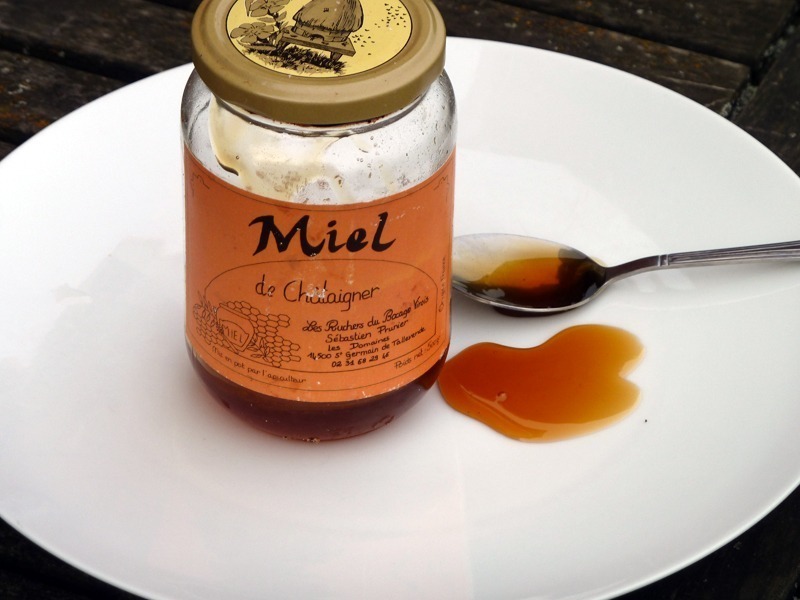
I love honey. I also love France and visit whenever I’m able to, often returning home to Britain with several jars of local French honey. The first time I came across Le Miel de châtaignier I was intrigued. My dictionary told me that this was honey of the sweet chestnut (Castanea sativa). But, surely, sweet chestnut is wind-pollinated so how was it possible that bees were collecting its pollen and the French apiculturers (beekeepers) were able to make sweet chestnut honey?
The literature tells us that sweet chestnuts are wind-pollinated but I’m not so sure that this is completely accurate. As Peter Thomas explains in his excellent book (Trees: their natural history p. 133), in reality there is a blurring between wind and insect-pollination in trees, with the pollen of all the major European wind-pollinated trees (ash, birch, hazel and oak) having been found on honey bees.
In the case of sweet chestnut it has sticky pollen, which you will notice if you brush your finger against a flower. Its flowers are also sweet-smelling and always seem to attract a lot of insects. Typically, wind-pollinated flowers do not have sticky pollen and do not smell sweet. Furthermore, try tapping a sweet chestnut flower to see if a cloud of pollen is released as it is for wind-pollinated trees such as alder, hazel or walnut:- it is not. So, in my view, sweet chestnut is most definitely insect-pollinated and perhaps almost exclusively.
Sweet chestnut honey is quite dark and strong-tasting, and not necessarily my favourite for spreading on bread or toast although it’s excellent in cooking. Here’s a summary of the some of the popular, and less well-known, tree honey varieties.
Acacia
Acacia honey, made from Acacia spp. tree flowers, is remarkably clear and pure and is one of the most popular and sweetest of honey varieties. Due to a high level of fructose it stays as a liquid (i.e. not crystallising) for a long time. Its low sugar content makes it the honey of choice for diabetics. It has a neutral taste (unlike sweet chestnut honey!) making it a popular with children and suitable for sweetening drinks.
Lime
Lime honey is produced from the cream-coloured flowers of the lime or basswood (Tilia spp.), having a light colour yet a strong taste. Some say it has a ‘woody’ flavour and it is a popular honey for marinades and salad dressings.
Eucalyptus
Eucalyptus honey is a popular and widely-produced honey. Given the large number of different Eucalyptus species, its honey differs widely in colour and taste. Generally it has quite a herbal taste, with a hint of menthol, and may not be to everybody’s tastes (especially children). It is said to be an effective cure for colds and headaches.
Leatherwood
Leatherwood honey is made from the flowers of Eucryphia lucida, a small tree native to Tasmania. It has a unique floral yet spicy flavour and is considered a gourmet honey, being exported around the world. It is excellent in cooking as it adds not only sweetness but a wonderful aroma to cakes and muffins, and to warm beverages.
Pine
This is a generic honey, similar to ‘forest honey’, and is a popular honey in Greece. It has a strong smell and is not very sweet, having a rather bitter taste. It is a little like Acacia honey in that it will remain a liquid for a long time.
Strawberry Tree
Strawberry Tree or arbutus honey comes from the small tree Arbutus unedo native to the Mediterranean; where in Sardinia it is known as miele amaro (bitter honey). As this suggests, it has a strong bitter flavour but it is appreciated by honey connoisseurs.
Sweet Chestnut
Sweet Chestnut honey is made from the flowers of Castanae sativa and has a strong aromatic flavour and a slightly bitter after taste. It is dark in colour and richly aromatic, some say pungent! It is not very sweet and slightly bitter.
Tawari
Tawari honey is made from Ixerba brexioides native to New Zealand. The honey is golden in colour and is said to have a butterscotch flavour that is very subtle. It is prized in the kitchen for desserts, being a favourite on pancakes and ice cream.
Gabriel Hemery
 This work is licensed under a Creative Commons Attribution- NonCommercial- NoDerivs 3.0 United States License.
This work is licensed under a Creative Commons Attribution- NonCommercial- NoDerivs 3.0 United States License.

This is for Gabriel. I too am a great amateur of honey, being an ex-beekeeper. You must try ivy, oak, dandelion, spring honey from fruit trees (elixir). The pine honey you mention is largely from the sweet extrusions from the aphids which feed on the pines, and which ants ‘farm’. Hence the taste. And buckwheat,mainly from Canada,is also great. Manuka us ovetrated: sales worldwide are twice the amount produced, so it is largely a rip off.